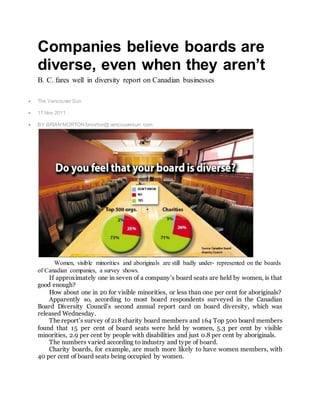
Companies believe boards are diverse_MAguayo_InterviewCBDC
- 1. Companies believe boards are diverse, even when they aren’t B. C. fares well in diversity report on Canadian businesses The Vancouver Sun 17 Nov 2011 BY BRIAN MORTON bmorton@ vancouversun. com GLENN BAGLO/ PNG FILESWomen, visible minorities and aboriginals are still badly under- represented on the boards of Canadian companies, a survey shows. If approximately one in seven of a company’s board seats are held by women, is that good enough? How about one in 20 for visible minorities, or less than one per cent for aboriginals? Apparently so, according to most board respondents surveyed in the Canadian Board Diversity Council’s second annual report card on board diversity, which was released Wednesday. The report’s survey of 218 charity board members and 164 Top 500 board members found that 15 per cent of board seats were held by women, 5.3 per cent by visible minorities, 2.9 per cent by people with disabilities and just 0.8 per cent by aboriginals. The numbers varied according to industry and type of board. Charity boards, for example, are much more likely to have women members, with 40 per cent of board seats being occupied by women.
- 2. For corporate boards, women are best represented on boards of utility companies ( 21.7 per cent) and finance companies ( 19.6 per cent), and least represented on mining, oil and gas company boards ( 6.6 per cent). Despite that, 73 per cent of the Top 500 board members surveyed felt their board was diverse, while 71 per cent of charitable board members felt the same. Even 60 per cent of mining and oil and gas companies thought their board was diverse. “The gap in the reality and perception in board members in how they think in terms of their boards being diverse is interesting,” the council’s senior coordinator, Michelle Aguayo, said in an interview. “We were very surprised. In their opinion, they believe the boards are diverse. But for the most part, they’re still struggling to support diversity.” Nevertheless, the council’s founder, Pamela Jeffery, said in an introduction to the study she found it encouraging that 47 per cent of corporate board members and 61 per cent of charity board members identify the issue of board diversity as being very important. In a separate report released Wednesday evening, the council analyzed the boards of the largest 250 corporations included in the Report on Business 1,000 and identified 56 as board diversity leaders. Leading the pack was Husky Energy whose 14- member board includes eight members who are of a visible minority, two of them women. Five British Columbia companies were on the list, led by Silvercorp Metals, whose six- member board includes three from a visible minority, and Spectra Energy Transmission which has a three- member board that includes one woman and one member of a visible minority. Teck Resources, HSBC Bank Canada and Capstone Mining were the other three B. C. companies to make the list. Elizabeth Watson, former chair of the governance committee for the Institute of Corporate Directors and president of Vancouver- based Watson Advisors Inc., a business governance and leadership advisory group, said in an interview that the council report highlights several issues, including the fact that women are under- represented in Canada’s boardrooms. “The numbers of women on boards hasn’t moved significantly over 10 years. B. C. is average, close to 15 per cent. Alberta is about six per cent,” Watson said. One reason many boards believe they are diverse is because their definition of diverse might differ from council’s, she said. Another is that a 15- member board might have one or two women now when a few years ago it was all male. In another study released Wednesday, Catalyst along with Harvard Business School found that having more women on boards could lead to more corporate social responsibility. The report said that in 2007, the average charitable donations of companies with three or more female directors were 28 times higher than companies with no female directors.